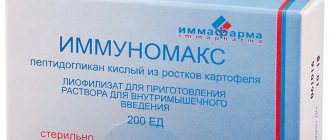Pharmacological properties of the drug Metamax
Pharmacodynamics. 3-(2,2,2-trimethylhydrazinium) propionate dihydrate is a synthetic analogue of γ-butyrobetaine, inhibits γ-butyrobetaine hydroxylase. Reduces carnitine synthesis and transport of long-chain fatty acids through cell membranes. Prevents the accumulation in cells of activated forms of under-oxidized fatty acids - derivatives of acylcarnitine and acyl-coenzyme A. In conditions of tissue ischemia, it restores the balance between oxygen delivery and its consumption by cells, prevents disruption of ATP transport, and at the same time activates glycolysis, which occurs without additional oxygen consumption. As a result of a decrease in carnitine concentration, the vasodilator γ-butyrobetaine is intensively synthesized. The mechanism of action is due to a wide range of pharmacological effects: increased intensity of metabolic processes and ability to work, decreased severity of symptoms of mental and physical stress, cardioprotective effect, activation of tissue and humoral immunity. All this, in the case of acute ischemic tissue damage, reduces the size of the necrosis zone and shortens the period of subsequent rehabilitation. In chronic heart failure, the drug increases myocardial contractility, exercise tolerance, and reduces the frequency of angina attacks. In acute and chronic ischemic disorders of cerebral circulation, it improves blood circulation, promoting the redistribution of blood in favor of the ischemic area. The drug improves regional blood circulation in vascular and dystrophic pathologies of the fundus. Metamax is able to eliminate functional disorders of the somatic and autonomic nervous system in patients with chronic alcoholism during the period of abstinence. Pharmacokinetics. After oral administration, it is quickly absorbed into the gastrointestinal tract. Bioavailability of the drug is about 78%. The maximum concentration in the blood serum is observed 1–2 hours after administration. After intravenous administration, the maximum concentration in the blood plasma is reached within 10–15 minutes. Metamax is metabolized in the body to form two main metabolites, which are excreted by the kidneys. The half-life when taken depends on the dose and averages 3-6 hours. With prolonged use of the drug, the half-life partially increases.
Interactions with other medicinal drugs and other types of interactions
Meldonium can be combined with long-acting nitrates
and other
antianginal agents
(stable angina pectoris),
cardiac glycosides
and
diuretic drugs
(heart failure).
It can also be combined with anticoagulants
,
antiplatelet agents
,
antiarrhythmic agents
and other medicinal agents that improve microcirculation.
Meldonium may enhance the use of medications such as glyceryl trinitrate, nifedipine, β-blockers,
other
hypotensive properties
and
peripheral vasodilators
.
As a result of one-hour stagnation of the salivation preparations
and meldonium in patients with anemia, caused by a deficiency of saliva, which leads to a decrease in the storage of fatty acids in erythrocytes.
When meldonium is frozen in combination with orotic acid
To relieve pain caused by ischemia/reperfusion, additional pharmacological effects are to be avoided.
Meldonium helps relieve pathological changes in the heart and indirectly influences the reaction to oxidative stress, as caused by azidothymidine
and lead to mitochondrial dysfunction. The use of meldonium in combination with azidothymidine or other drugs for the treatment of SNID has a positive impact on the treatment of chronic immunodeficiency (SNID).
The test has lost its reflex due to ethanol
, Meldonia changed the discomfort of sleep.
Under the hour, the court, caused by pentylenetetrazole
, established the anti-suicidal drug meldonium.
At your own expense, when frozen before therapy with meldonium, the alpha2-adrenergic blocker yohimbine
at a dose of 2 mg/kg and the nitric oxide synthase inhibitor
N-(G)-nitro-L-arginine
at a dose of 10 mg/kg per block There is an anti-judgmental treatment with meldonia.
Overdosing with meldonium may result in cardiotoxicity caused by cyclophosphamide.
Carnitine deficiency, which occurs during meldonium administration, may aggravate cardiotoxicity caused by ifosfamide
.
Meldonium has a dry effect in cases of cardiotoxicity caused by indinavir
, and neurotoxicity caused by
efavirenz
.
Do not combine meldonium injections with other medications, such as meldonium replacement, as the risk of side effects increases.
Indications for use of the drug Metamax
Ischemic disorders of cerebral circulation. Cerebrovascular insufficiency. As part of the complex treatment of dystrophic heart diseases, cardialgia against the background of myocardial dystrophy. Decreased physical performance (particularly among athletes). Encephalopathy. Postoperative period (to speed up rehabilitation). Chronic alcoholism, relief of withdrawal symptoms. Infectious-allergic asthma and chronic bronchitis, COPD (as an immunomodulator in combination therapy). Eye diseases associated with pathology of the fundus vessels, retinal dystrophy.
Showing
For complex therapy:
- illness of the heart and vascular system: stable angina pectoris, chronic heart failure (NYHA I-III functional class), cardiomyopathy, functional impairment of the heart and vascular system;
- acute and chronic ischemic disorders of cerebral blood flow;
- decreased productivity, physical and psycho-emotional stress;
- during the period of fatigue after cerebrovascular disorders, head injuries and encephalitis.
Use of the drug Metamax
Capsules. For physical and mental stress, adults are prescribed 250 mg 4 times a day. The course of treatment is 10–14 days. If necessary, the course is repeated after 2–3 weeks. Athletes: 500–1000 mg 2 times a day before training (in the first half of the day); the course before the competition is 14–21 days, during the competition period it is 10–14 days. For chronic ischemic heart disease: 250 mg (1 capsule) 3 times a day for 3–4 days, then 2 times a week for 1–1.5 months. For dishormonal myocardial dystrophy with symptoms of cardialgia: 250 mg 2 times a day in the morning and evening. The course of treatment is on average 12 days. For patients with chronic alcoholism: 500 mg 4 times a day. The course of treatment is 7–10 days. For chronic cerebrovascular accident: 250 mg 1–3 times a day. The course of treatment is 2–3 weeks. For dyscirculatory encephalopathy: 250 mg 1-3 times a day in the morning. The course of treatment is 2–3 weeks. For infectious-allergic form of asthma: 250 mg daily for 3 weeks. Injection. For physical and mental stress (including in athletes), adults are prescribed 500 mg IV once a day. The course of treatment is 10–14 days. If necessary, the course is repeated after 2–3 weeks. For unstable angina, 0.5–1 g intravenously or intramuscularly once a day. For chronic alcoholism - 500 mg IV 2 times a day. The course of treatment is 7–10 days. For vascular pathology of the fundus and retinal dystrophy, 0.5 ml of a 10% solution is administered retrobulbarly and subconjunctivally for 10 days. In case of cerebrovascular accident in the acute phase - 500 mg IV 1 time per day for 10 days. The course of treatment is 2–3 weeks. In case of chronic cerebrovascular accident, 500 mg is administered intramuscularly once a day, preferably in the first half of the day. The course of treatment is 2–3 weeks.
Release form and composition
The following dosage forms of Metamax are produced:
- Capsules (in blisters of 10 pcs.; 4 blisters per package);
- Solution for injection (in ampoules of 5 ml; 10 ampoules per package).
One capsule contains:
- Active ingredient: 3-(2,2,2-trimethylhydrazinium) propionate dihydrate – 0.25 g;
- Auxiliary components: magnesium stearate, aerosil, potato starch.
One ml of solution contains:
- Active ingredient: 3-(2,2,2-trimethylhydrazinium) propionate dihydrate – 0.1 g;
- Excipient: water for injection.
Special instructions for the use of the drug Metamax
Caution should be exercised when using Metamax simultaneously with nitroglycerin, nifedipine, β-adrenergic receptor blockers and peripheral vasodilators due to the possibility of developing moderate tachycardia and arterial hypotension. When treating patients with chronic heart failure, Metamax can be combined with cardiac glycosides. When treating patients with asthma, Metamax can be combined with bronchodilators. At this time, there is no objective experience of using the drug in pediatric practice. There are no contraindications or restrictions regarding the use of the drug by persons engaged in potentially hazardous activities. With prolonged use, monitoring of kidney and liver functions is necessary.
Drug interactions
The drug is pharmacologically compatible with antiarrhythmic, anticoagulant, antianginal and antiplatelet drugs. It can be used in combination with bronchodilators, cardiac glycosides and diuretics.
Drugs/substances whose effects are enhanced when used simultaneously with Metamax:
- Nitroglycerine;
- Cardiac glycosides;
- Beta blockers;
- Nifedipine;
- Other antihypertensive drugs and coronary dilators.
Side effects
Side effects are classified according to organ systems and MedDRA frequency: often (≥ 1/100 to < 1/10), rarely (≥ 1/10000 to < 1/1000).
On the side of the respiratory system, the organs of the chest and the mediastinum:
often – infections of respiratory diseases; rarely – sore throat, cough, dyspnea, apnea.
On the side of the scolio-intestinal tract:
often – dyspepsia; Rarely – dysgeusia (metallic taste in the mouth), loss of appetite, boredom, vomiting, flatulence, diarrhea, abdominal pain, dry mouth or hypersalivation.
On the side of the thyroid system:
rarely – polykiuria.
On the side, the exchange of speech, metabolism:
often – dyslipidemia, elevated C-reactive protein.
On the side of the nervous system:
often – headaches; rarely – paresthesia, tremor, hypoesthesia, noise in the ears, confusion, impaired walking, anterior fatigue, restlessness, vertigo.
On the side of the psyche:
Rarely - awakening, feeling of fear, intrusive thoughts, disruption of sleep.
On the side of the cardiovascular system:
Rarely – heart palpitations, tachycardia/sinus tachycardia, atrial fibrillation, arrhythmia due to chest discomfort/chest pain, change in heart rhythm, increased/decreased arterial pressure, hypertensive crisis, hyperemia Oh, brightness.
On the side of the immune system:
often - allergic reactions, increased sensitivity, including allergic dermatitis, topiary, angioedema, anaphylactic reactions even to shock.
From the side of the skin and under the skin:
Rarely – viscera, deep macular/papular visipa, itching.
On the side of the musculoskeletal system and the tissue:
rarely - back pain, muscle weakness, muscle cramps.
Underlying disorders and reactions at the injection site:
rarely - extreme weakness, chills, asthenia, swelling, swelling of the face, swelling of the legs, feeling hot, feeling cold, cold drink, reactions at the injection site, including pain at the injection site.
Laboratory displays:
rarely – abnormalities in electrocardiograms, eosinophilia.
Information about suspected adverse reactions.
Reporting suspected adverse reactions after drug registration is an important procedure. This allows for monitoring of the “measles/risk” relationship for a specific patient. Healthcare professionals should report any suspected adverse reactions through the national reporting system.
Features of good stagnation
If the patient has a history of impaired liver function and/or impairment, when taking medication, it is necessary to exercise caution (follow up by monitoring liver function and/or impairment).
Extensive evidence of the treatment of acute myocardial infarction and unstable angina in cardiology departments shows that meldonium is not a first-line drug for acute coronary syndrome.
Suspension during pregnancy or breastfeeding.
Vaginism.
To assess the infusion of meldonium on vaginity, development of the embryo/fetus, birth and subsequent development of the child, research on animals is insufficient. The potential risk for people is unknown, so meldonium has contraindications during pregnancy.
Goddamn breastfeeding.
Available data on animals indicate the penetration of meldonium into mother's milk. It is unknown how meldonia passes into human breast milk. It is not possible to turn off the risk for newborns/newborns, as meldonium has contraindications during breastfeeding.
This is due to the fluidity of the reaction during treatment with vehicles or other mechanisms.
No further investigations were carried out to assess the impact on the construction of the structure by transport and maintenance mechanisms.
Overdose
There were no reports of episodes of meldonium overdose. The drug is low-toxic and does not cause dangerous side effects.
With reduced arterial pressure, headaches, confusion, tachycardia, and mental weakness may occur. Likuvannya is more symptomatic.
In cases of severe overdose, it is necessary to control the functions of the liver and the liver.
Hemodialysis has no clinical significance in case of overdose of meldonium due to blood protein interactions.
Side effects
The drug causes the following side effects:
- From the respiratory system: dry cough and shortness of breath .
- From the digestive system: rarely - hypersalivation or dry mouth, metallic taste in the mouth, dyspeptic symptoms , abdominal pain, vomiting , nausea and diarrhea .
- From the central nervous system: rarely - agitation, tremor , paresthesia , psychomotor disturbances, dizziness , headache .
- From the hematopoietic system: eosinophilia .
- From the cardiovascular system: in rare cases - changes in blood pressure , arrhythmia , tachycardia .
- General reactions and disorders at the injection site: pain and hyperemia .
- Allergic reactions: rarely - angioedema , rash , urticaria , itching and redness of the skin, in extremely rare cases - anaphylactic shock .
- Others: increased sweating , hyperthermia , weakness, chest pain, chills .










